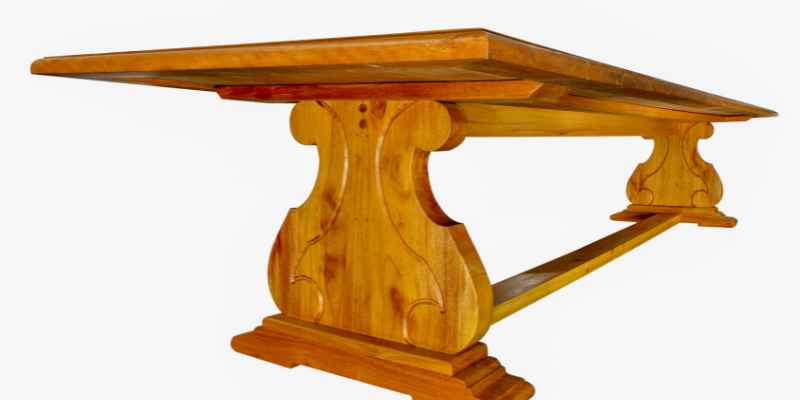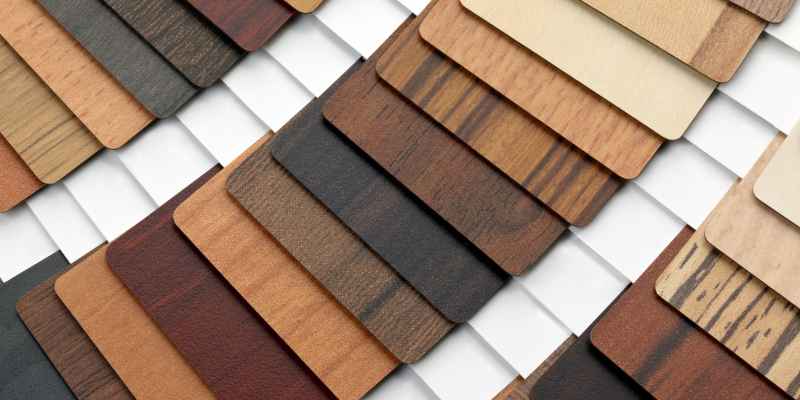Walnut wood and mahogany wood are both strong and durable, but mahogany wood has a tighter, more prominent grain and is highly durable, making it ideal for high-quality indoor furniture, musical instruments, and outdoor projects. Walnut wood and mahogany wood are both popular options for furniture and other wood-based projects.
While they share some similarities, there are also significant differences between the two woods. Walnut wood is known for its chocolate brown color and creamy sapwood that creates a beautiful contrast, making it an elegant and stylish option. Meanwhile, mahogany wood has a more classic or antique appearance ideal for certain home aesthetics.
One of the most significant differences between walnut wood and mahogany wood is their grain structure. While walnut wood has a distinctive open grain pattern and features distinct knots, mahogany wood has a tighter, more prominent grain, making it more durable and resistant to termites, moisture, and temperature changes. Both woods have their unique advantages and disadvantages and can suit different applications and preferences.
Appearance
Walnut wood and mahogany wood have distinct differences in appearance. Walnut wood has a chocolatey brown color with creamy sapwood, while mahogany wood has a tighter, more prominent grain with impressive durability. Both are strong and durable, but preference may depend on the desired aesthetic and style of the project.
When it comes to choosing between Walnut Wood and Mahogany for your next project, one of the things that you need to consider is their appearance. Both woods have their unique aesthetic appeal, so it’s important to choose the right one for your project based on your preferences. Let’s take a closer look at the appearance of Walnut Wood vs Mahogany.
Grain Pattern
The grain pattern of Walnut Wood is generally straight, but can also have a slight wave or curl to it. Its open pores give it a more natural and rustic look, which can be emphasized with the right finish. On the other hand, Mahogany Wood features a tighter, more prominent grain pattern that creates an elegant and sophisticated look. Its interlocking grain also adds a distinct character to the wood that makes it stand out.
Color Variation
The color of Walnut Wood ranges from light to dark brown with hints of purple or red in some cases. It also features a creamy white sapwood that creates a sharp contrast with the darker heartwood. Mahogany Wood, on the other hand, has a reddish-brown color that gets darker over time. Its color variation depends on the tree species and the location it was sourced from.
In conclusion, both Walnut Wood and Mahogany have their unique appearance that can work well for specific projects. If you’re looking for a more natural and rustic look, Walnut Wood can be a great choice. On the other hand, if you prefer a more elegant and sophisticated look, Mahogany Wood might be the better option. Ultimately, it boils down to personal preference and the overall aesthetic that you want to achieve.

Properties
Both walnut wood and mahogany are strong and durable, but mahogany has a tighter and more prominent grain. Additionally, mahogany is ideal for high-quality indoor furniture and musical instruments, while walnut can be used for a wide range of applications and has a stunning grain pattern.
Choose the wood that best fits your needs and aesthetic preferences.
When it comes to choosing between walnut wood and mahogany, it’s important to consider their properties. Density, strength and durability are three of the most important properties that distinguish these two woods.
Density
In terms of density, mahogany is superior to walnut wood. Mahogany has a higher density, making it heavier and more suitable for applications that require a heavier wood, such as furniture, doors and musical instruments.
Strength
Mahogany wood is also stronger than walnut wood. It has better resistance to impact and bending, making it a better choice for high-traffic areas and outdoor projects.
Durability
Both walnut and mahogany can withstand the elements, but mahogany is more rot-resistant and has a tighter, more prominent grain, which helps to limit water absorption and improve its resistance to moisture. It makes mahogany the better choice for outdoor use, such as in decks and patios.
In conclusion, when it comes to choosing between walnut wood and mahogany, it’s important to carefully consider their properties. While walnut wood offers a beautiful grain pattern and elegant appearance, mahogany is superior in terms of density, strength and durability. Whether you’re looking for a wood for indoor or outdoor use, mahogany is the better choice for its superior properties.
Uses
Walnut wood offers a beautiful and durable option for various projects, while mahogany features a tighter and more prominent grain. Mahogany is ideal for high-quality indoor furniture and musical instruments, as well as outdoor projects and flooring due to its impressive durability.
Ultimately, the choice between walnut wood and mahogany depends on the specific needs and aesthetic preferences for the project at hand.
When it comes to choosing the right type of wood for your project, there are a number of factors to consider, including appearance, properties, and of course, uses. Both walnut and mahogany are popular choices for a variety of projects, but each wood has its own unique characteristics that make it better suited for certain applications. In this section, we’ll take a closer look at the various uses for walnut and mahogany, breaking them down into three main categories: indoor/outdoor furniture, musical instruments, and flooring.
Indoor/Outdoor Furniture
Both walnut and mahogany are popular choices for indoor furniture due to their durability and beautiful appearance. However, when it comes to outdoor furniture, mahogany is often the preferred choice due to its rot-resistant properties. Mahogany furniture can last for decades even when exposed to the elements, making it an excellent choice for outdoor dining sets, patio furniture, and more. Walnut can also be used for outdoor furniture, but it requires more maintenance and may not last as long.
Musical Instruments
Mahogany is a popular choice for acoustic guitars and other musical instruments due to its warm, rich tone and excellent resonance. It is also lightweight and easy to work with, making it a top choice for instrument makers around the world. Walnut is also used for musical instruments, but it is not as common as mahogany. It is often used for guitar bodies and other parts that require a strong, durable wood.
Flooring
Both walnut and mahogany are beautiful choices for hardwood flooring. Walnut has a warm, inviting tone that looks great in both modern and traditional homes. Its unique grain pattern and beautiful knots make it a popular choice for high-end flooring projects. Mahogany is a darker wood with a tighter grain pattern that gives it a more polished look. It is also harder and more durable than walnut, making it a better choice for high-traffic areas.
In conclusion, both walnut and mahogany are excellent choices for a variety of projects. However, when it comes to choosing between the two, it’s important to consider the specific needs and uses of your project. Whether you’re looking for indoor or outdoor furniture, musical instruments, or hardwood flooring, both walnut and mahogany have unique characteristics that make them ideal for certain applications.
Advantages Of Walnut Wood
When it comes to choosing wood for your projects, walnut wood is one of the best options that you can have. This versatile wood has a lot to offer, making it popular among woodworkers and furniture makers alike. Here are some of the advantages of walnut wood:
Elegance
Walnut wood has a beautiful and elegant appearance that appeals to many homeowners. With a chocolatey brown color contrasting against the creamy sapwood, it effortlessly provides a touch of sophistication and luxury. The natural color variations give an alluring purplish tinge, which enhances the overall look of the wood.
Stunning Grain Pattern
One of the most distinctive features of walnut wood is its stunning grain pattern. It has a open and straight grain pattern, which means that it showcases a range of beautiful knots and patterns that are perfect for creating visually appealing furniture pieces. The grain also has a unique texture that looks great when you use it with other types of wood.
Strong And Durable
Walnut wood is a strong and durable wood that is immune to decay and insect damage. This means that it can withstand harsh weather conditions, making it perfect for outdoor use, including decks, patios, and furniture. It also has good dimensional stability, which means that it resists warping and twisting and can be used for a variety of projects. It is also easy to work with both hand and machine tools, making it a favorite among woodworkers.
In conclusion, walnut wood is a popular choice for innumerable reasons, including its elegant appearance, stunning grain pattern, and superior durability. With its strength and resistance to decay, walnut wood is perfect for a variety of projects, from high-end indoor furniture to outdoor projects.
Advantages Of Mahogany Wood
Walnut wood offers strong and durable qualities that are great for creating furniture and other objects, while mahogany wood boasts a more impressive durability and tighter, more prominent grain. Mahogany is ideal for indoor furniture, musical instruments, and outdoor projects and flooring, making it a superior choice to walnut wood in terms of density and strength.
Mahogany wood is known for its superior quality and durability, making it an ideal choice for a wide range of applications. Here are some of the advantages of using mahogany wood for your projects.
Density
Mahogany wood is significantly denser than walnut wood, making it stronger and more durable. This density also lends itself well to carving, producing intricate designs with sharp lines and details.
Workability
Despite its density, mahogany is surprisingly easy to work with by both hand and machine tools. It is also easily sanded, glued, stained, and finished, allowing for a wide range of customization options.
Resistance to Termites and Moisture
Mahogany wood is highly resistant to termites, moisture, and temperature changes, making it ideal for outdoor projects such as decking, siding, and fences. This resistance ensures that your projects will last for years without succumbing to damage from pests or the elements.
Overall, the advantages of mahogany wood over walnut make it a preferred choice for many furniture makers, woodworkers, and builders. Its strength, workability, and resistance to termites and moisture all contribute to its unparalleled quality and versatility.
Disadvantages Of Walnut Wood
Despite its attractive appearance, walnut wood has certain disadvantages compared to mahogany, such as being less dense and weaker in strength. It also tends to be more expensive than other woods.
Open Grain
One of the major disadvantages of walnut wood is its open grain. Due to its open pores, walnut tends to absorb moisture quickly, making it prone to warping, swelling, and shrinking. This can be a problem, especially if you live in a region with high humidity. Moreover, the open grain of walnut makes it more difficult to finish than other wood types. The stain or finish may not penetrate evenly, leading to uneven coloring and patchy appearance.
Less Density And Strength Than Mahogany
Compared to mahogany, walnut wood has less density and strength, making it less durable and resistant to wear and tear. Its softness makes it prone to scratches and dents, making it less suitable for high-traffic areas. Additionally, walnut wood is not as strong and sturdy as mahogany, which makes it less ideal for structural applications.
In conclusion, while walnut wood has its aesthetic appeal, it may not be the best option when it comes to durability, strength, and practicality. Its open grain and lower density and strength compared to mahogany make it more susceptible to wear and tear, making it more suitable for decorative purposes rather than heavy use.
Disadvantages Of Mahogany Wood
Mahogany wood has tighter, more prominent grain and impressive durability, making it ideal for high-quality indoor furniture and musical instruments to outdoor projects and flooring. However, when compared to walnut wood, it is heavier and has lower strength and density, making it less ideal for some applications.
Mahogany wood is a popular choice for furniture and home decor due to its durability and impressive appearance. However, there are some disadvantages to consider before choosing mahogany wood for your next project.
Price
Mahogany wood is known for its high price point compared to other hardwoods like walnut. Its popularity and limited growth in certain regions can drive up the cost of the wood. The price may be a factor for those on a tight budget or for those who want to use it for smaller projects.
Darkening of Color Over Time
One of the disadvantages of mahogany wood is that it tends to darken in color over time due to prolonged exposure to sunlight. While some people appreciate the deeper color that results, others may not want their furniture to darken in this way. It is important to note this characteristic if you are planning to use mahogany wood for a project that is likely to get a lot of sun exposure.
Overall, while mahogany wood has its disadvantages, such as high cost and darkening of color over time, it is still a great option for those looking for strong, durable wood for their furniture and decor.

Frequently Asked Questions For Walnut Wood Vs Mahogany
Which Wood Is Better Walnut Or Mahogany?
Both walnut and mahogany woods have impressive durability. Walnut wood has a beautiful appearance with a chocolatey brown color and a creamy sapwood while mahogany wood has a tighter and more prominent grain. Mahogany wood is ideal for a wide range of applications, from high-quality indoor furniture and musical instruments to outdoor projects and flooring.
It’s a personal preference based on the look you want to achieve.
What Are The Disadvantages Of Walnut Wood?
Walnut wood has higher chances of warping and cracking due to its open grain structure. It also requires regular maintenance, including polishing and conditioning, to maintain its luster and shine. Additionally, walnut wood is relatively soft, making it more susceptible to scratches and dents.
Which Wood Has The Prettiest Grain?
Walnut wood is considered to have the prettiest grain. Its chocolate brown color with creamy sapwood and purplish tinge, forms a stunning pattern that adds elegance to any object. However, Mahogany wood has tight and more prominent grain, making it ideal for various applications due to its durability.
Why Is Mahogany Wood So Special?
Mahogany wood is special because of its tight grain, extensive durability and rot resistance to termites, moisture, and temperature changes. It is a versatile wood and perfect for various applications such as high-quality indoor furniture, musical instruments, outdoor projects, and flooring.
Its workability is exceptional, allowing it to be sanded, glued, stained, turned, and finished effortlessly.
Conclusion
Overall, when it comes to choosing between walnut wood and mahogany, it really depends on your specific needs and preferences. Both woods have their own advantages and disadvantages. Walnut wood is perfect for those who value affordability, elegance, and contemporary design, while mahogany wood is more durable, denser, and has a timeless, classic look.
Ultimately, the decision depends on your budget, style, and what purpose you need the wood for. Whether you opt for walnut or mahogany, remember that both woods have their own unique beauty and charm that can enhance any space they are used in.


